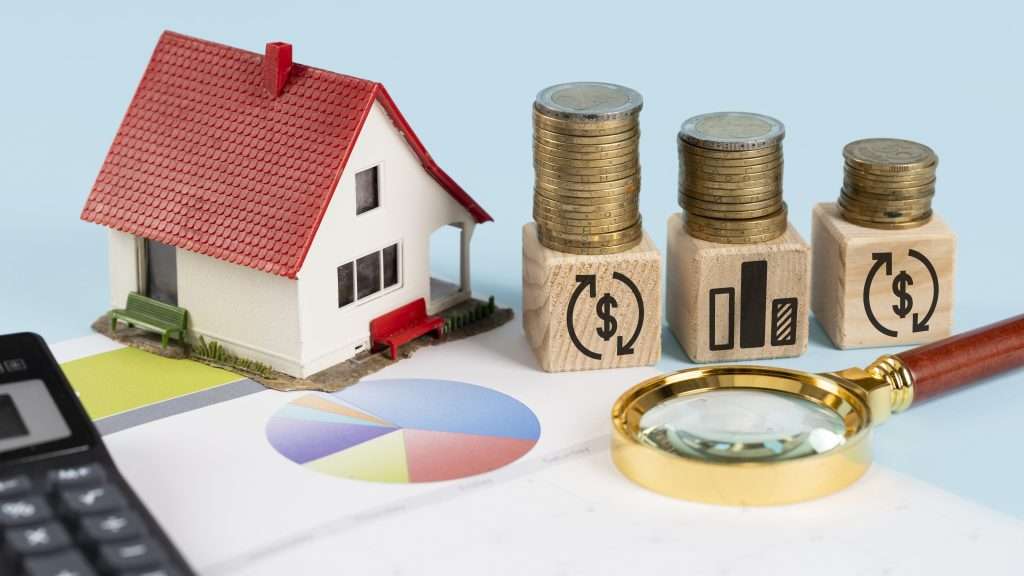Turning your vision of a new house into reality is an exciting prospect. But before the hammers swing and the sawhorses appear, a crucial first step is nailing the financial side. Building a house can be a complex financial endeavor, so careful planning is essential. This guide will equip you with the knowledge you need to understand the critical financial steps in building a new house in 2024.
Contents
ToggleBudget & Savings
A solid financial foundation is crucial for a successful build. Here’s what you need to consider:
- The All-Encompassing Budget: First, create a comprehensive budget that factors in everything – land purchase (if needed), construction costs, permits, closing costs, and a buffer for unexpected expenses. Think of it as your roadmap to financial success.
- Prioritize Needs vs. Wants: Differentiate between essential features (bedrooms, bathrooms) and desirable extras (high-end appliances, swimming pool). This helps allocate funds effectively.
- Saving Up for Success: Aim for a 20% down payment on your construction loan. A larger down payment translates to a lower loan amount, meaning less interest paid over time. This can save you a significant amount of money in the long run.
Remember: Unexpected expenses are almost inevitable. Building materials might fluctuate in price, or unforeseen permitting delays could arise. A buffer in your budget helps you absorb these bumps along the road without derailing your dream home.
Selecting a Home Builder

Selecting the right home builder is crucial for the success of your project. Here’s what to consider:
- Experience & Reputation: Research the builder’s experience level and look for positive customer reviews.
- Communication Style: Ensure clear and consistent communication with the builder to avoid misunderstandings.
- Contract Review: Have a lawyer or financial advisor review the builder’s contract to ensure all terms are clear and protect your interests.
Get quotes from builders to estimate costs in your area. Colorado’s average home building cost is $200-$300 per square foot. In Minnesota, it’s $150-$250; in Denver, it’s $250-$350.
Loan Options
Building a house requires significant upfront costs, so financing is essential. Here are the two main loan options to consider:
- Construction Loan: This temporary loan covers the building process itself. Typically, these loans offer interest-only payments during construction, reducing your initial financial burden. Once the house is complete, the construction loan becomes a permanent mortgage you’ll pay off over time.
- Permanent Mortgage: This is the long-term loan you’ll use to finance your finished home. Getting pre-approved for a mortgage helps you understand your borrowing capacity and allows you to set a realistic budget for your project.
Tip: When exploring loan options, compare interest rates and terms from different lenders. Finding the most competitive loan can save you thousands of dollars in the long run.
Pre-Construction Costs
There are additional costs to consider before the construction phase even begins:
- Professional Fees: Architects translate your vision into blueprints while engineers ensure structural soundness. Expect fees to range from $5,000 to $12,000 for architects and $3,000 to $7,000 for engineers (averages for Colorado, Minnesota, and Denver).
- Permits & Licenses: Building permits and licenses are mandatory for construction. Costs vary depending on location, so contact your local building department for specific information.
- Soil Testing: Understanding soil composition is crucial for building a solid foundation. A soil test typically costs between $500 and $1,000.

Remember: These are just average costs. Getting quotes from local professionals and the building department in your area is essential to get the most accurate figures.
Your Financial Health Check-Up
Before starting your new home journey, assessing your current financial situation is crucial. Here’s how:
- Gather Your Documents: Collect your recent pay stubs, bank statements, and any existing debt documentation.
- Calculate Your Debts: Total your monthly debt payments, including credit cards, car loans, and other outstanding debts.
- Assess Your Income: Determine your net monthly income (your take-home pay after taxes and deductions).
- Evaluate Your Credit Score: Your credit score impacts loan interest rates. Aim for a good credit score (generally above 670) to secure the most favorable loan terms.
Tip: Many banks and credit unions offer free credit score reports. Checking your score allows you to identify areas for improvement, potentially saving money on your construction loan.
A Breakdown of Construction Costs
The actual construction cost is a significant portion of your budget. Here’s how to approach it:
- Location, Location, Location: Construction costs vary greatly depending on your area. Research the average construction cost per square foot in your location. Nationally, this can range from $150 to $300 per square foot, but significant variations exist.
- Beyond the Square Footage: Construction costs go beyond just the size of your house. Consider additional fees for the foundation, roof, plumbing, electrical, HVAC systems, and interior finishes.
Tip: Once you have a base construction cost per square foot, multiply it by your desired square footage to get a rough estimate. Be sure to factor in additional costs for features you want to include.
Managing Unexpected Cost Overruns
Even the most meticulous plans can encounter unforeseen circumstances. Here’s how to handle them:
- Build in a Buffer: Dedicate a portion of your budget to unexpected costs. Material prices might fluctuate, labor shortages could occur, or you might decide on changes during construction (change orders). Having a buffer helps you absorb these unexpected expenses without derailing your project.
- Track Your Expenses: Maintain meticulous records of all expenses throughout the build process. Spreadsheets or project management tools can be helpful for efficient tracking. This allows you to monitor your spending and identify areas for potential adjustments if needed.
Remember: Communication is vital! Regularly discuss potential cost changes with your builder and get everything documented in writing. This will help avoid misunderstandings and keep your project on budget.
Final Steps
- Final Inspection: Before celebrating, ensure everything meets building code standards. Schedule a final inspection with a qualified professional to verify the house is safe and up to code.
- Closing the Deal: It’s time to finalize your permanent mortgage and closing procedures once the inspection is complete. This involves paperwork and fees but ultimately leads to you becoming the official homeowner!
Congratulations! You’ve turned your dream home into reality by following these steps and carefully managing your finances.
Bonus Tip: Seek Professional Help
Building a house is a complex project. Consider enlisting the help of a financial advisor or experienced builder. They can provide valuable guidance throughout the process, helping you navigate financial decisions and make informed choices.
Building your dream home is a journey, not just a destination. Planning, budgeting, and preparing for the unexpected can turn your vision into a beautiful, financially sound reality.